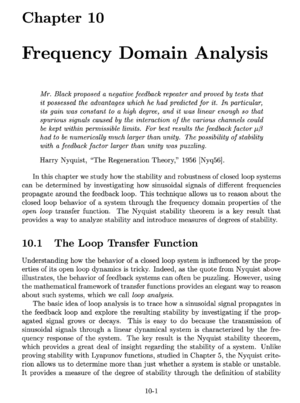Difference between revisions of "Frequency Domain Analysis"
Jump to navigation
Jump to search
(Created page with "{{Chapter |Chapter number=10 |Previous chapter=Transfer Functions |Next chapter=PID Control }}") |
Tag: Undo |
||
| (7 intermediate revisions by the same user not shown) | |||
| Line 1: | Line 1: | ||
{{Chapter | {{Chapter | ||
|Chapter number=10 | |Chapter number=10 | ||
| + | |Short name=loopanal | ||
|Previous chapter=Transfer Functions | |Previous chapter=Transfer Functions | ||
|Next chapter=PID Control | |Next chapter=PID Control | ||
| + | |First edition URL=https://www.cds.caltech.edu/~murray/amwiki/index.php?title=Frequency_Domain_Analysis#Frequently_Asked_Questions | ||
| + | |Chapter summary=In this chapter we study how the stability and robustness of closed loop systems can be determined by investigating how sinusoidal signals of different frequencies propagate around the feedback loop. This technique allows us to reason about the closed loop behavior of a system through the frequency domain properties of the open loop transfer function. The Nyquist stability theorem is a key result that provides a way to analyze stability and introduce measures of degrees of stability. | ||
| + | |Chapter contents=# The Loop Transfer Function | ||
| + | # The Nyquist Criterion | ||
| + | #* The Nyquist Plot | ||
| + | #* The General Nyquist Criterion | ||
| + | #* Conditional Stability | ||
| + | # Stability Margins | ||
| + | # Bode's Relations and Minimum Phase Systems | ||
| + | # Generalized Notions of Gain and Phase | ||
| + | #* System Gain and Passivity | ||
| + | #* Extensions of the Nyquist Criterion | ||
| + | #* Describing Functions | ||
| + | # Further Reading | ||
| + | :: Exercises | ||
}} | }} | ||
Latest revision as of 16:36, 24 November 2024
| Prev: Transfer Functions | Chapter 10 - Frequency Domain Analysis | Next: PID Control |
In this chapter we study how the stability and robustness of closed loop systems can be determined by investigating how sinusoidal signals of different frequencies propagate around the feedback loop. This technique allows us to reason about the closed loop behavior of a system through the frequency domain properties of the open loop transfer function. The Nyquist stability theorem is a key result that provides a way to analyze stability and introduce measures of degrees of stability.
Contents
- The Loop Transfer Function
- The Nyquist Criterion
- The Nyquist Plot
- The General Nyquist Criterion
- Conditional Stability
- Stability Margins
- Bode's Relations and Minimum Phase Systems
- Generalized Notions of Gain and Phase
- System Gain and Passivity
- Extensions of the Nyquist Criterion
- Describing Functions
- Further Reading
- Exercises
